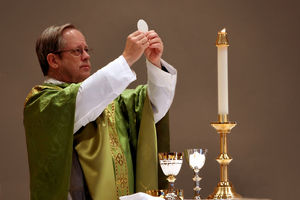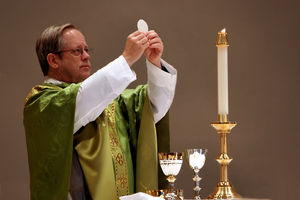
What is Christian “Worship”?
- October 7, 2013
- / Category 1 Corinthians 11, Acts 2, Commentary, Ephesians 2, Eucharist, Galatians 3, Passover, Romans 14
- / Posted By Kevin Bennett
- / No Comments.
Contents
Worshipping in Spirit and in Truth

- Mike_tn / Foter / CC BY-NC-ND
Let’s look at where Christian worship began, what it was like then, and what it meant to the first Christians. Much has happened through subsequent church history, but how much of what we now call “worship” is directly related to what the first Christians would have called “worship”?
Let’s look at the Eucharist, and expand from there.
Origins of Christian Worship
The origins of the explicitly Christian gathering are recorded most famously in Acts 2. The disciples in the upper room had been “constantly devoting themselves to prayer” (Acts 1:13), presumably in prayer relating to the promise Jesus had just made (1:8), when the Pentecostal fire fell on them. After the influx of converts at Pentecost, the rapidly swelling fellowship is described in Acts 2:42ff. There are four specific activities described for that early Christian community. They are summarised as: devotion to “the apostles’ teaching and fellowship, to the breaking of bread and to the prayers”.
It is commonly assumed that the Eucharistic Supper (bread and wine) was being referenced here, and that it is directly linked to Passover. A closer look forces a re-evaluation of these assumptions.
In the Beginning
Acts 2:42ff reflects that the community was operating in a state of semi-realised eschatology:[1] “a new age had dawned”![2] But this community was not practicing specific worship rituals beyond their culturally normal Jewish ones (Acts 2:5; cf. 2:46). They had no theological imperative to perform any particular rituals, but they had a strong cultural link to many of the Old Testament worship patterns, such as Sabbath keeping. Paul addresses these cultural norms, teaching that they are allowed, but not mandated (Rom 14). Jesus instructed his followers to repeat the Last Supper as a memorial, but did not specify how often, nor in what specific format.
So what did the first converts think they were doing?
From their point of view the onlookers at Pentecost had just witnessed the promise foretold by their own prophet (Acts 2:16-21), and then were told that by virtue of being Israelites, they were implicated in the death of the “Lord and Messiah” (Acts 2:22-36; cf. Acts 3:14-15). However, there was a way by which they could be forgiven for that self-evidently heinous crime against God, and be separated from “this corrupt generation” (Acts 2:40 cf. Romans 7:6); namely, “repent and be baptised … in the name of Jesus Christ” (Acts 2:38 cf. Acts 3:19-20). They would therefore not only have forgiveness, but they and their children would be heirs to this promised Holy Spirit (2:38-39).
So they were initially celebrating concepts which were specific to their particular Jewish cultural and religious perspective on the Gospel message. The presence of bread at the gatherings is mentioned, but without reference to wine or any other indication of a special meal. They were celebrating the fact that the “Age to come” was upon them. Ritual worship was not called-for.
I have a supper you know not of…
Similarly in Jesus’ post-resurrection appearances among his followers there is no evidence that they were liturgically repeating the Last Supper, as suggested by some commentators. Indeed in Luke 24:42 they were eating fish! Patterson tentatively suggests that Luke 24:13-35 could be a postdictive reference to Eucharist,[3] but that is the least likely explanation. Jesus’ actions more likely have functioned as a trigger for recalling the miraculous feedings (Luke 9:16-17 cf. 24:30, 35), and not the Last Supper.
In Corinth, Paul describes the regular church meeting in terms of a full meal with elements reminiscent of a family meal in a Jewish home,[4] but not as a Passover. Although he downplays his eschatological descriptions of the church because he is controlling the problem of an “overrealised” eschatology among the Corinthians (so Fee),[5] he is consistently teleological, rather than trying to invent a religion of liturgy and ceremony. His instructions about the Eucharist are designed not to invent ritual, but to curb social excesses (1 Corinthians 11:21, cf. vv33-34), and the meal is based on the Last Supper, not the Passover (11:25-26). He lays out the theological basis for the meal (11:27), without mentioning any Passover motifs.
The Jew/Gentile difference
Corinth was a predominantly Gentile congregation (1 Corinthians 12:2). There is, in fact, no mention of the Jewish believing communities venerating a frequent Eucharist. Gonzalez rightly observes this, but incorrectly concludes that it was “centuries later”,[6] before Christ’s death was celebrated through the Eucharist. The Corinthian meal is explicitly about Christ’s death,[7] signified by the bread and wine allegory of blood and body (11:26). This was important to Gentiles because it is the blood that establishes the covenant (11:25), by which Gentiles are finally incorporated into “the promise” (Galatians 3:29; cf. Ephesians 2:13). Of course, the giving of the Spirit is directly and causally linked to Jesus’ death (John 16:7), but each of the distinct cultural groups, Jew and Gentile, were viewing the Gospel from their own perspective.[8]
The apparent neglect of Jesus’ Eucharistic instructions (Luke 22:19) by Jewish believers does actually make sense if they related his instructions exclusively to the observance of the annual Passover meal, which for them is an understandable symbol of continuity between Old Testament and New Testament worship.[9] But Eucharist and Passover were not necessarily seen as coterminous at Corinth. Paul invokes “our paschal lamb, Christ…” (1 Corinthians 5:7), not in connection with the Eucharistic meal of chapter 11,[10] but instead as a reference to purity. Therefore the paschal symbolism was relevant for Corinth for other motifs, but not in direct connection with Eucharist.
Other aspects of worship were seemingly contextualised by the Jew/Gentile differences as well.[11] About a hundred years later, long after the tectonic shift in Jew/Gentile dealings which was precipitated by the temple destruction of 70AD, Justin’s writings indicate that the Eucharist had “been separated from the supper” (so Webber),[12] as an expressly religious rite. It is overly simplistic to say, “Christians realised early in the second century that the Lord’s Supper completely replaces the Passover”,[13] because Passover had not been “abolished” but fulfilled (cf. Matthew 5:17), in Christ. It is this fulfilment that Christians are celebrating (1 Corinthians 11:26). The Supper presupposes the Passover; it does not replace the Passover.
What is Christian Worship?
The unbiblical phenomenon of denominations
Denominations obsess and squabble over the Eucharist and how it is to be celebrated. When Paul said “there is one body” (Romans 12:4-5; 1 Corinthians 10:17; 12:12; Ephesians 4:4; Colossians 3:15), it was not wishful thinking, nor a naïve observation. It was a theological ipso facto statement. Where we find denominational distinctives, we do not have one correct and many incorrect pictures of the Christian faith. Just as Jews and Gentiles worshipped differently in the 1st Century, each for their own purpose, today we have the opportunity to learn about various points of view from which to appreciate the Gospel message. Indeed, much of Paul’s ministry was the reconciliation of these two previously mutually exclusive cultural groups, made into one body in the crucified Christ (Ephesians 2:11-22), but understandably retaining distinct practices (Romans 14:1-23). The Biblical “one body” phenomenon is in fact the antidote to a “wilderness of distain” (per Dearborn),[14] which occurs in factionalised groups.
The “Biblical framework”, up to which the life of the believing community should live, is not defined by ritual, pomp, liturgy, song, preaching, architecture, Baptism, nor even Eucharist. It is defined in the very terms by which Abraham’s life was assessed: “he believed the Lord; and the Lord reckoned it to him as righteousness” (Genesis 15:6). The prophets repeatedly brought the same essential message, typified in Micah 6:6-8, revealing the cultic rituals as lacking intrinsic worth, and presenting godliness as the proper acceptable offering required by God (eg. Isaiah 1:10-17 cf. Isaiah 58:1-14). The “believing community” is so called because it is “belief” which defines it, after Abraham’s legacy (Romans 4:11-12). It offers the proper acceptable offering that has been perpetually sought by God (Romans 12:1-2).
Of course, the “acceptable offering” of Romans 12:1-2 can adequately be offered through the stylistic characteristics of any and all of the many denominations, home-churches, and in any earnest gathering in Jesus’ name, held for the sake of believing what God has said, done, and promised. As Brown suggests, it is “a matter of taste”.[15] The point at which any one style is judged as being less authentic based on doctrinal differences, or by appeals to Biblical precedent, is precisely the point at which the accuser stands judged (Matthew 7:2). Each tradition has its strengths and weaknesses, but there is “one body” (1 Corinthians 12:12), and the eye cannot say to the hand, ‘I have no need of you’ (v21).
The common ground
There is no doubt that “worship” is a concept with which the believing community should be intimately concerned. The procedural content of that worship, however, has not been prescribed by Scripture, and with good reason: worship is not a procedure. Worship frequently happens during various procedures, and often during procedures designed to promote worship, but the performance of the procedure is not the essence of worship. Whatever is done in love for God, which is indivisibly also love for neighbour (Matthew 22:39, Mark 12:31-33, Luke 10:27 cf. Romans 13:9-10, Galatians 5:14), is received by God as worship, and it has never been otherwise (cf. Genesis 4:6-7). Furthermore, whatever is done without love is worthless (1 Corinthians 13:1-3 cf. Matthew 7:21-23).
Christian worship is, therefore, manifested and realised in acts of Christian love. The two are coterminous and almost synonymous.
Bibliography
Dearborn, Tim Coil Scott. Worship at the Next Level : Insight from Contemporary Voices [in English]. Grand Rapids, MI: Baker Books, 2004.
Dowley, Tim. The History of Christianity [in English]. Oxford, England; Batavia, Ill., USA: Lion Pub., 1990.
Fee, Gordon D. The First Epistle to the Corinthians [in English]. Grand Rapids, Mich.: W.B. Eerdmans Pub. Co., 1987.
González, Justo L. The Early Church to the Dawn of the Reformation. The Story of Christianity. 1st ed. San Francisco: Harper & Row, 1984.
Ladd, George Eldon, and Donald Alfred Hagner. A Theology of the New Testament. Rev. ed / edited by Donald A. Hagner. ed. Grand Rapids, Mich.: William B. Eerdmans, 1993.
Thiselton, Anthony C. The First Epistle to the Corinthians : A Commentary on the Greek Text. The New International Greek Testament Commentary. Grand Rapids, Mich. Carlisle: W.B. Eerdmans ; Paternoster Press, 2000.
Webber, Robert. The Biblical Foundations of Christian Worship [in English]. Nashville, Tenn.: Star Song Pub. Group, 1993.
———. The Complete Library of Christian Worship [in English]. Peabody, Mass.: Hendrickson Publishers ;, 1993.
White, Susan J. White Susan J. Foundations of Christian Worship [in English]. Louisville, Ky.: Westminster John Knox Press, 2006.
Related
facebook comments:
Recent Posts
- Addiction: How to Help
- … and this just in: News from the Streets of Ipswich. Issue 23
- What Happens When We Die, and Where are my Loved Ones?
- Seeking the Kingdom
- If it is by the Spirit of God that I drive out demons, then the Kingdom of God has come upon you – Matt 12:28
Tags
| S | M | T | W | T | F | S |
|---|---|---|---|---|---|---|
| « May | ||||||
| 1 | 2 | 3 | 4 | 5 | 6 | |
| 7 | 8 | 9 | 10 | 11 | 12 | 13 |
| 14 | 15 | 16 | 17 | 18 | 19 | 20 |
| 21 | 22 | 23 | 24 | 25 | 26 | 27 |
| 28 | 29 | 30 | ||||



